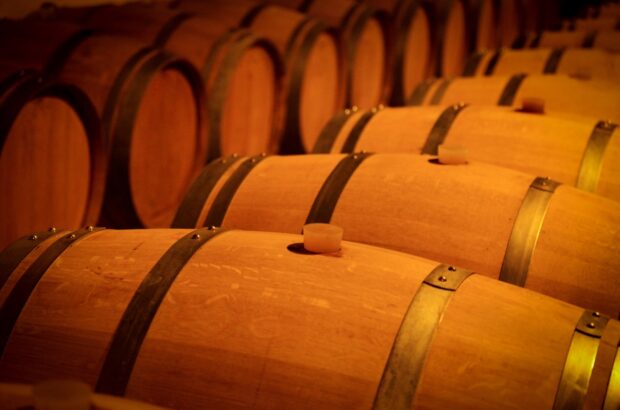Gin is a clear spirit that is made by distilling fermented grain and a number of other botanicals, one of which by law must be juniper. We take a closer look at Gin, how it's made and the essential facts...
Gin
What is Gin made of?
Gin is a clear spirit that is made by distilling fermented grain and a number of other botanicals, one of which by law must be juniper. Gin is essentially pure ethanol, or flavourless vodka, that is flavoured through re-distillation with a range of natural ingredients.
Although inextricably linked to the UK, and often regarded as England’s national spirit, it originates from Holland where the first mention of juniper-based health-related drinks appeared in a Dutch publication in 1269.
By the mid-17th century, numerous Dutch distillers had popularised the re-distillation of malt spirit with juniper and other spices including anise and caraway (to mask the spirit’s bad flavour) which were sold in pharmacies and used to treat an array of medical problems. From then Gin built up a history of medicinal usage particularly by the Royal Navy, who are said to have mixed it with lime to stop scurvy and angostura to settle the stomach while at sea.
Top gin deals
Gin’s arrival in England during the mid-17th century stemmed from the discovery of genever by British troops stationed in Holland who saw Dutch soldiers drinking the juniper-flavoured liquor to boost morale before heading into battle during the Thirty Years’ War. It was at this time that the term ‘Dutch Courage’ was said to have been created.
Eventually, the English took the idea of making and drinking Gin back with them. The combination of a newly crowned Dutch king drinking his native spirit and an ease in production at the time gave Gin a firm foothold with the English drinker.
Gin drinking rose significantly following the passing of the Distilling Act in 1690, allowing unlicensed production as well as heavy duties imposed on all imported spirits such as French brandy.
Thousands of gin shops emerged across London in a period known as the Gin Craze and because of the low prices started to be consumed regularly by the poor.
Acts of Parliament were passed to regulate Gin’s production in pot stills and, over time, the later styles of gin became distinctly different to the Dutch or Belgian ones (jenevers or genevers) that evolved from malt wine spirits.
The subsequent invention and development of the column still made the distillation of neutral spirits practical and created the London Dry style that came to the fore later in the 19th Century.
Today, Gin is globally one of the most popular spirits making its mark in almost every country in the world that consumes alcohol.
It is also experiencing a renaissance with new craft and artisan gin brands and distilleries emerging all over the globe – 315 currently in Britain more than double the number five years ago.
Essential info:
- Colour: Generally clear, though some infused gins carry a slight hue
- Region: Produced heavily in the UK but can be made anywhere, historically in Holland. There are 13 gins that have a ‘protected geographical indication’ most famously Plymouth Gin which has been made in Plymouth since 1793.
- ABV: Minimum 40% ABV
- Made from: Usually a grain mash (wheat, barley or corn), but can be made from any mash, or in some cases grape spirit, to produce a neutral spirit that is then either redistilled or infused predominantly with juniper berries. Distillers are free to add any other natural ingredients and botanicals to achieve a target taste – herbs, fruit, nuts, spices and honey are common additions.
- Translation: Widely regarded as being derived from the Dutch word for ‘juniper’ which is ‘jenever’ that was then Anglicised to ‘ginever’ and then to ‘gin’.
Manufacturing process
Gin is made similarly to Vodka with the neutral alcohol being highly concentrated ethanol, which by law must be of agricultural origin. This is normally a grain, but some gin producers use ethanol from grapes, sugar beet or molasses. Grain spirits are preferred as they give the Gin a crisper texture whereas molasses-based spirits can give an impression of softness and sweetness.
The ethanol is purified by repeat distillations to reach a minimum strength of at least 96% alcohol by volume.
Most houses don’t actually make the base spirit from which they create their gins. Rather they buy in the neutral alcohol from third party distillers with pharmaceutical companies the dominant suppliers.
There are three main type of distillation used for Gin production:
- Pot Distilled Gin: A process used to make many early gins which were produced by distilling the fermented malt wine known as the ‘mash’ from grains and then distilling it a second time with botanicals to impart flavour.
- Column Distilled Gin: The most common process and one which became mainstream upon the invention of the Coffey still. This produces a very concentrated spirit that gets redistilled a second time with the addition of juniper berries and other botanicals in a ‘gin basket’ that’s suspended in a pot still allowing for flavour extraction as the heat from the vapor rises. London dry gin is made through column distillation.
- Compound Gin: A process that is used but not as often as distilled gin. It is the cheapest way to flavour a gin. The required flavours are simply added to the base spirit without redistilling it. The resulting gin can have a pronounced immediate intensity, but the flavours can taste artificial and often fade quickly.
Botanicals
- Juniper – An element gin distillers have no control over as juniper grows wild rather than being cultivated. Juniper berries grow in bushes on thorny branches and contain three years’ worth of growth at the same time. They are sourced mainly from the Tuscany region of Italy (as well as Serbia, Macedonia, India and in small quantities the Scottish Highlands) and are hand harvested by locals from October to February who have to hit each branch carefully with a stick to get the ripe berries to fall off. Juniper berries vary in their aromatic properties but generally have a pleasant floral taste with a distinct and assertive wood and pine flavour.
Other botanicals:
- Spicy: Coriander, Nutmeg, Cinnamon, Cardamom, Ginger, Nutmeg
- Sweet: Honeysuckle, Elder flower, Vanilla
- Earthy: Angelica root, Liquorice, Rosemary
- Floral: Lavender, Hibiscus
- Nutty: Almond
- Zesty: Lemon peel, Orange peel, Bergamot
Basic styles
London Dry Gin– unlike Scotch or Cognac, London dry gin can be made anywhere in the world. ‘London Dry’ is a reference to the style of gin production rather than an indication of production location. By law London Gin must be processed by redistilling the neutral spirit in a pot still in the presence of juniper and other botanicals. Essentially, it is for styles that generate flavours through distillation as opposed to post-distillation either by including them in the mix, macerating for varying lengths of time, or allowing distilled vapour to pass through them extracting flavour as they go.
Distilled Gin – is made the same way as London Dry except other flavours may be added after distillation – a practise increasing in popularity for experimental producers who can blend different distillates with their gins. These new styles can use exotic flavours, are highly sought after, and can command premium prices.
Plymouth Gin – one of the 13 Protected Geographical Indications, Plymouth Gin must be made in Plymouth, on the south coast of England. It is slightly less dry than the more common London style of gin due to a higher than usual proportion of root ingredients which impart an earthier feel to the gin.
Old Tom – is often called the ‘missing link’ in classic gin flavour profiles as it is slightly sweeter than London Dry but slightly drier than the Dutch Jenever. Old Tom was the original gin used for the popular Tom Collins cocktail and the gin of choice for much of the 18th and early 19th Centuries.
Navy Strength – characterised by an uncommonly high proof, 57% ABV and above. This was the traditional strength demanded by the British Royal Navy. Its inception was the result of spilled gin below ship decks failing to ignite the adjacent gun power they were stored next to. Officers began to suspect their gin supplies were being diluted by dishonest distillers or merchants and started testing the gin to ensure they received gin of the proper strength, at least 114 proof – today’s 57%.
New styles
Cask-ageing – Some producers have been experimenting with ageing gin in casks –allowing the finalised spirit to rest in oak barrels. These gins receive additional flavours from the wood adding a different dimension to the traditional juniper-based varieties. Commercially available aged gins are rare, with the exception of Beefeaters Burrough’s Reserve which is small batch distilled and rested in Bordeaux casks after distillation – it’s also recommended to be consumed neat.
Alcoholic strength
In the European Union, the minimum bottled alcohol strength for gin, distilled gin and London gin is 37.5% ABV (alcohol by volume). In the United States, gin is defined as an alcohol beverage of no less than 40% ABV.
Tasting Gin
Unlike vodka and tequila which can be drunk neat, or bourbon and whisky which can include ice or a splash of water, gin is meant to be mixed. The range of botanicals used add varying complexities and flavours making it the perfect base for so many classic cocktails.
How to taste Gin like a professional – read more
Did you know?
Gin was once known as ‘mother’s ruin’. During the first half of the 18th Century, England experienced the ‘Gin Craze’. This was a period noted for the rapid and widespread consumption of Gin and an epidemic of extreme drunkenness in London. The spirit’s reputation in the capital was so bad it earned the name ‘mother’s ruin’ due to the reckless abandon with which it was consumed by women at the time.
The Gin and Tonic was invented by the army of the British East India Company at the height of the British Empire. It was developed in the 19th Century as a way to make quinine (which Scottish doctor George Cleghorn said at the time could be used to prevent and treat malaria) more palatable for British officers who were at risk of catching the disease while stationed in India. Since officers were already given a gin ration they took to adding a mixture of water, sugar, lime and gin to the quinine creating the famous G&T.
Best-selling Gin brands in the world
- Ginebra San Miguel – a Philippines based gin, first produced in 1834, that is by some margin the best-selling gin brand in the world. It sells over 200 million bottles a year, mainly in its home market where roughly 22 bottles are consumer every second. The Philippines makes up approximately 43% of the entire world market for gin.
- Gordon’s – one of the oldest Gin brands in the world having been produced for almost 250 years (it still uses the same recipe, same ingredients and distillation methods). It is the biggest selling gin brand in the UK and in 2016 sold 50% more Gin than closest rival Bombay Sapphire.
- Bombay Sapphire – produced through triple distillation with the vapors passed through a basket containing 10 botanicals for a soft infusion of herbal flavour. The name originates from the gin’s popularity in India during the British Raj and refers to the Star of Bombay, a 182-carat sapphire from Sri Lanka, which is on display at the Smithsonian Institute. The sapphire also inspired the gin’s iconic crystalline blue bottle.
- Tanqueray – originally distilled by Charles Tanqueray in 1830 and made in London. Production was moved to Scotland after its distillery suffered massive bomb damage during World War II. Tanqueray is a London dry gin and made by the double distillation of grain with botanicals added during the second distillation. Its largest market is the US where it is the best-selling imported gin.
- Beefeater – this brand’s name refers to the Yeomen Warders who are the ceremonial guards of the Tower of London – who also famously adorn the gin’s bottles. Beefeater has been distilling in London since 1876. It is one of only 9 distilleries still operating in the city itself. In 2017, the brand launched a new red bottle design for its Beefeater 24 gin, made from a blend of 12 botanicals including Japanese Sencha and Chinese Green tea.
- Seagrams – the best-selling gin in the US earning the self-appointed name of ‘America’s Gin’ or ‘America’s #1’. It was founded in 1857 in Ontario but was first introduced to America’s cocktail culture post-prohibition in 1939. Its taste profile includes a distinctive citrus taste with hints of orange peel, cinnamon and lilac in the nose.
- Larios – Spain’s best-selling gin and newcomer to the UK market in 2016. The Larios family were involved in cane processing before moving into distillation in 1863 launching Larios Gin – according to the London dry gin method – in 1932. Now owned by Beam Suntory.
- Hendrick’s – Scotland based Hendricks launched in 1999 and is famed for using Bulgarian rose and cucumber in its gin to add flavour (as well as 11 other botanicals). It’s commonly suggested that the gin be served with tonic water over ice garnished with a slice of cucumber in place of the traditional citrus. It has a famous and unique dark brown, apothecary-style bottle.
- Gin Mare – Another Spanish brand on the best-selling gin list. Launching in 2010, Gin Mare is made in a former monk’s retreat in the small fishing village of Vilanova just outside Barcelona. It uses Turkish rosemary, Greek thyme, Spanish citrus and Italian basil in its botanical line-up reflecting its Mediterranean origin.
15 British Gin brands to know
| Brand name | Production location |
| The Botanist | Isle of Islay, Scotland |
| Brighton Gin | Brighton |
| Bloom Gin | Warrington |
| Chase | Herefordshire |
| East London Liquor Company Batch No.2 | London |
| Pinkster | North Herefordshire |
| Sipsmith | London |
| Star of Bombay | Hampshire |
| The Lakes Gin | Lake District |
| Portobello Road | London |
| Trevethan | Cornwall |
| Caorunn Gin | Scottish Highlands |
| Maiden | Maidstone |
| Silent Pool | Guildford |
| Porter’s Gin | Aberdeen |
Classic Gin drinks / cocktails
There are more classic cocktails made with Gin than with any other spirit:
- Gin Martini
- Gimlet
- Gin & Tonic
- Negroni
- Tom Collins
- French 75
- Gin Sling / Singapore Sling
- Red Snapper
- The Last Word
- White Lady
- Vesper
How to make the perfect martini
The classic dry gin martini is an iconic cocktail and an ideal choice for gin lovers. It requires minimal preparation and because it only has a few ingredients allows the chosen gin to show off its true characteristics.
- Start by placing both your Martini glass and gin in the freezer – at least an hour before serving. The high level of alcohol will prevent the gin from freezing but it will take on a slightly viscous, syrupy texture as it chills.
- When it’s time to pour, traditionally 1-part dry vermouth would be added to 4-parts gin. But a dry martini today is actually defined as using little to no vermouth. A common suggestion is to minimise the quantity or simply rinse the glass with a little dry vermouth to give a hint of flavour.
- Then pour in at least 50ml of the chilled gin – quality counts so go for a top-shelf gin.
- Garnish with an olive to add an extra oily dimension or a delicate twist of fresh lemon zest.
Every gin is different so the ratio between gin and vermouth may need changing according to taste, as may the garnish.








